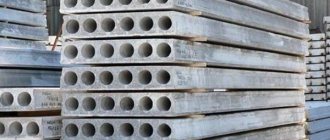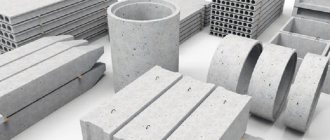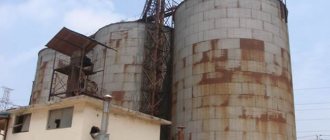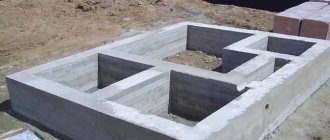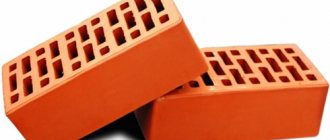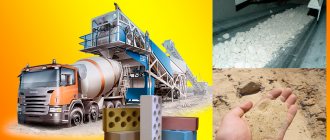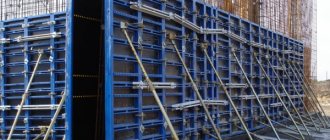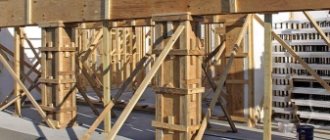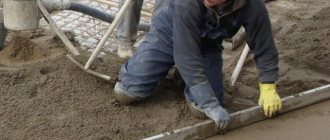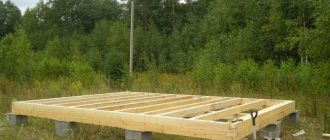Caisson means “box” in French.
And in construction, this is the name for ceilings or internal surfaces dissected into elements, formed with recesses around cross beams. The ribbed shape of monolithic structures allows you to save on concrete, reduces the load on supporting structures, and reduces construction costs.
What does the concept mean?
In any building, at the time of erecting a coffered ceiling, the openings between the walls are covered with slabs of different materials and shapes . When using a coffered concrete floor, reinforced concrete ribbed structures made using a special technology are used.
If you look at the fragment with the lower section, you can see a reinforced rib with stretched reinforcement, where there is no concrete. In this case, the location of the ribs can be perpendicular to each other, sometimes at an angle, at a distance of approximately 150 cm. The slabs are laid on these protrusions.
Such a ceiling can be monolithic or prefabricated , on main and auxiliary beams of the same height. After installation, the ceiling will have square, rectangular or diamond-shaped recesses, but all these recesses resemble peculiar boxes, which is why French builders called the ceiling technique coffered.
But this architectural concept originated in ancient times. Such arrangement was seen on frescoes and mosaics of ancient Egypt, Greece, and Rome.
The photo shows how the transverse and longitudinal beams are covered by a continuous flooring, and the free space is filled with various decorations in the form of drawings, stucco moldings or sculptural ornaments.
Where and when is it appropriate?
With coffered ceilings, it is economically profitable to build massive buildings loaded with engineering structures, where it is planned to move a large flow of people.
Eg :
- entertainment or construction complex;
- cinema, theater;
- educational institution;
- shopping mall.
In megacities, there are almost no large manufacturing enterprises left within the city limits; they have been moved outside of large populated areas. But the buildings have not gone away; they are rebuilt and often use coffered technology for ceilings. It is advisable to use a similar method of overlap if complex large-sized equipment in the form of overhead cranes is used in construction.
When it is necessary to carry out installation with additional elements on high-rise complexes, caisson technology allows for reliable and safe operation of the structure with optimal functionality.
Areas of application of coffered ceilings
The structures have proven themselves to be excellent in constructing floors in heavily loaded engineering structures and in buildings with large circulation of people (sports and shopping complexes, theaters and cinemas, educational and educational institutions, etc.). In large Russian cities, to improve the environment, production facilities are moved outside the city limits. The demolition of large volumetric buildings is not always economically feasible, so they are often converted into various multifunctional centers. In production buildings for the operation of overhead cranes, the height of the premises is ≥ 10 m. To ensure the functionality of the conversion, such a high space is divided into floors by installing additional floors. Coffered structures are optimal for this.
It should be noted that despite the obvious advantages of coffered structures in comparison with traditional flat structures, their use in Russia has not yet become widespread, unlike in many European countries (Spain, Germany, Great Britain, Italy and others).
- Wall kit
Varieties
If we consider a coffered ceiling as a type of ribbed structure with reinforced protrusions that are perpendicular to each other, this is a technological feature of construction.
Here the height of the protruding elements is set in two sections:
- in the middle of the rib, where the greatest load falls;
- in a place adjacent to the vertical support.
The height on a continuous monolithic section is controlled by lateral force. The calculation of coffered floors is carried out taking into account constant, short-term, long-term loads and their derivative combinations.
Based on the technical features of the production of coffered ceilings, manufacturing technology is divided into the following types.
Prefabricated monolithic
The basis of the arrangement is a hollow block of different sizes. After laying, closed geometric shapes are obtained , which remain in the concrete in the form of permanent formwork. At the junction of the parts with the column, the structure looks like a solid slab. Concrete blocks above the support area are reinforced with reinforcing mesh or rods.
Monolithic
Here the concrete solution is evenly distributed. The absence of concrete on the ribbed structure makes the structure lightweight. During the work, only the reinforcement with ribs is concreted; the stretched sections of the section are left without mixture.
As a result, they save on building materials and increase the spans to be covered. The formwork for the coffered ceiling is made of telescopic racks, metal lathing or plastic caisson formers.
The plastic form has slight adhesion to concrete, which can be easily removed after the solution has hardened. The lightweight design does not require the use of a lifting mechanism .
The formwork is simply and accurately fixed to the sheathing, after which a structure of channels for the ribs with hollow inventory cassettes is formed. A reinforcing mesh is placed on top and filled with concrete. The result is a reinforced concrete caisson structure, where the height of the protrusions is transferred from plastic forms. In places of support, installation takes place on a solid reinforced concrete monolithic slab.
Types of concrete floors
The following varieties exist:
- prefabricated;
- monolithic;
- prefabricated monolithic.
The main types of beamless floors: monolithic, prefabricated, precast-monolithic.
In order for a monolithic beamless floor to rest on columns, three types of capital structures are used in buildings that are built for production purposes. The contours and dimensions of the capitals are selected with a calculation that eliminates the pushing of the concrete slab along the perimeter of the capitals. The thickness of a beamless slab must be calculated provided that it has sufficient rigidity.
A floor without beams can be calculated using the limit equilibrium method.
With the help of experiments, it was established that for a monolithic slab (beamless), dangerous loads are considered to be strip load (which is distributed across the span) and continuous load, during which the pressure is distributed over the entire area.
With such loads, linear plastic hinges and slab fractures can be located using two methods.
The design of beamless floors takes into account an equal-span grid, which can be square or rectangular. Of these, the square one is more rational, and with a rectangular shape, the aspect ratio should be 1.5. Along the entire perimeter (contour), such a ceiling rests on the main walls, contour piping, or cantilevers beyond the capitals of the last columns.
Dependence of loads and fractures
Typically, three types of capitals are used: 1 - with a capital plate, 2 - with a break, 3 - straight capital.
If a strip load is used in the design, then in limit equilibrium three linear hinges are formed that connect the links at the break points. If, according to the design, a plastic hinge can form in the arch along the loading axis of the panels, then cracks will open at the bottom. Whereas in load-bearing walls, the plastic hinge is located at a certain distance from the axis of the column, which largely depends on the size and shape of the capital. In this design, the crack will open at the top. The last panels rest freely on the wall from the outer edge and form linear hinges at the support, near the first intermediate row of columns and in the span.
If the structure provides for continuous loading, then linear hinges will appear in the panels located in the middle, which will be mutually parallel and perpendicular to the rows of columns, and cracks will open at the bottom. With this arrangement, the panel will be divided by hinges into four elements, which in turn will rotate around load-bearing linear plastic hinges, and their axes will be located at an angle of 45° with respect to the rows of columns. Above the load-bearing plastic hinges (in the middle panels), cracks will open at the top, and at the same time the entire thickness of the slab is cut through the line of columns.
If the loading occurs taking into account the strip load, then for a break in a separate strip (at which two links are formed), the connection is made using three linear hinges, and the middle panel is calculated as follows. The sum of the span and load-bearing moments that are perceived by the slab section (at the location of the linear hinges) is equal to the beam moment of the sheet. The beam slab is reinforced with welded mesh, which can be rolled or flat. In spans, the grids are placed at the bottom, and on supports they are laid at the top.
Reinforcement of a beamless concrete slab is made using narrow meshes located mutually perpendicular to each other. In them, stretching occurs in two layers (in two directions). Near the columns, the mesh located at the top is moved apart or small holes are made in them to install rods that compensate for the broken reinforcement. Reinforcement of capitals occurs in order to absorb shrinkage and temperature forces.
Requirements for slabs
Regulatory documentation at the design stage of any ceilings, including coffered ceilings, presents builders and manufacturers with a number of requirements for the structure :
- sustainability;
- operational safety;
- reliability;
- ability to withstand loads.
The production of reinforced concrete products is based on a set of rules and regulations:
- SP 387.1325800.2018 – design of reinforced concrete structures, coatings and floors;
- SP 385.1325800 2022 – basic provisions for protecting buildings from destruction;
- SP 351.1325800 2022 – production of reinforced concrete products from lightweight concrete;
- SP 311.1325800.2017 – production of reinforced concrete from high-strength concrete;
- SP 63. 13330.2012 – basic provisions for concrete and reinforced concrete structures;
- SP 20.13330.2016 – conditions for loads and their effects;
- SP 52-101-2203 – concrete and reinforced concrete structures without prestressing reinforcement;
- GOST 26633-2015 – Specifications for concrete;
- GOST 12767-94 – general specifications for reinforced concrete floor slabs for large-panel structures;
- GOST 27751-2014 – basic requirements for the reliability of construction projects, part No. 6 talks about loads and types of influence of forces on the surfaces of buildings and structures.
Regardless of the type of frame, monolithic or prefabricated, the caisson partition is formed using formwork, work is carried out according to the drawings in accordance with the building codes and regulations of SNiP 12-03-2001 (parts 1, 2).
The procedure for calculating material requirements using an online calculator
After the calculation of the monolithic floor has been made and you know its overall dimensions, you need to calculate the required amount of materials.
Today, few people independently calculate the need for reinforcement and concrete, because you can use a special online calculator. It's convenient and takes just a few minutes. Photo 5. Compaction of concrete mixture during the construction of a monolithic slab
The calculation sequence is as follows:
- Enter the grade of concrete in the special field.
- Specify the length, width and thickness of the slab.
- Fill in additional fields (for example, the length of the reinforcement and the method of its fastening) if available.
- Click the “Calculate” button.
After this, the calculation calculator will automatically display all the necessary information, which includes the volume and weight of concrete, the recommended diameter of the reinforcement for the reinforcing frame, the size of the mesh cell, the amount of overlap of the rods during reinforcement, the required number of rods in meters and kilograms, as well as data on materials for constructing the formwork .
Photo 6. Smoothing the concrete mixture after pouring and compaction
In conclusion, we would like to remind you once again that the above data is based on the recommendations of building codes and regulations and is not relevant for all objects. Our experts strongly recommend entrusting the calculation of the parameters of a monolithic concrete floor to qualified specialists, who will calculate everything taking into account the expected short-term, permanent loads and other factors.
Floor slabs PK 63-12-8 AtV (Ryazan Concrete Concrete Plant No. 2) Only new slabs from the factory. PC floor slab for all types of buildings, length 6.3 m, width…
From 8402 RUR/pieceMore details
Floor slabs PB 60-12-8 (Ryazan reinforced concrete plant No. 2) Only new slabs from the factory. PB floor slab for all types of buildings, 6m long,…
From 9656 RUR/pieceMore details
Floor slabs PK 48-12-8 AtV (Ryazan reinforced concrete plant No. 2) Only new slabs from the factory. PC floor slab for all types of buildings, length 4.8 m, width…
From 7137 RUR/pcsRead more
Floor slabs PK 35-12-8 (Ryazan reinforced concrete plant No. 2) Only new slabs from the factory. PC floor slab for all types of buildings 3.5 m long, width...
From 5153 RUR/pcsRead more
Floor slabs PK 30-12-8 (Ryazan reinforced concrete plant No. 2) Only new slabs from the factory. PC floor slab for all types of buildings 3 m long, wide…
From 4479 RUR/pcsRead more
Floor slabs PK 72-12-8 AtVt-1 (Ryazan reinforced concrete plant No. 2) Only new slabs from the factory. PC floor slab for all types of buildings, length 7.2 m, width…
From RUB 11,821/pieceMore details
Floor slabs PK 42-12-8 (Ryazan reinforced concrete plant No. 2) Only new slabs from the factory. PC floor slab for all types of buildings, length 4.2 m, width…
From 6414 RUR/pcsRead more
Floor slabs PK 58-12-8 AtV (Ryazan reinforced concrete plant No. 2) Only new slabs from the factory. PC floor slab for all types of buildings, length 5.8 m, width…
From 7930 RUR/pcsRead more
Floor slabs PC 60-12-8 AtV (Ryazan reinforced concrete plant No. 2) Only new slabs from the factory. PC floor slab for all types of buildings 6 m long, wide…
From 7996 RUR/pcsRead more
Floor slabs PK 25-12-8 (Ryazan reinforced concrete plant No. 2) Only new slabs from the factory. PC floor slab for all types of buildings, length 2.5m, width…
From RUB 3,674/pieceMore details
Characteristics and parameters
The reliability of the caisson is ensured by reinforcement and compliance with the technical parameters of the slab, which has a thickness of 25-45 cm. The ribs rise above the surface by 20-40 cm, with absolute proportionality in accordance with established building codes.
The height of the protruding edges should be at least 1/20 of the span length. Coffered ceilings have no special restrictions in size; they can even be 35 x 35 meters . The panels are supported on walls or columns; in this case there must be at least 4 support points.
Modular skydome formwork is used to widen spans to reduce the thickness of the floor. To ensure quality, it is necessary to build structures in accordance with technical properties.
| Details | Brand | Laying method |
| Skydome | H350; H400 | On spans from 8 to 16 (m.) |
| Beams | Т120;160;200 | For supports, they are created according to markings; monolithic ones come in widths of 120, 160, 200 (mm.) |
| TF120, 160, 200 | On plywood, when forming monolithic beams, widths of 120, 160, 200 (mm) are used. | |
| Universal plugs | C120, 160, 200 | On wooden supports to securely fix the plastic "T" beam |
| CF120, 160, 200 | On a plywood or wood base to strengthen the plastic “T” |
The formwork must meet the technical specifications:
| Name | Options |
| Maximum thickness (cm.) | 70 |
| Installation height (m.) | 1.5-20 |
| Load on racks (t.) | 2.7 |
| Diameters of racks (mm.) | 57/2 |
| Stand height (cm.) | 100, 140, 150-440 |
| Length of space between flanges (cm.) | 50/100 |
| Length size of crossbars (cm.) | 50-200 |
| Operating temperatures | -400 C; +400C |
Volumetric formwork allows work to be carried out at a height of 20 meters, using floors up to 2 m thick and 5 tons in weight.
Types
Some of the most popular reinforced concrete slabs are products that resemble the letter “P” in configuration. Such structures can be found at various facilities, mainly industrial. The pitch of the load-bearing vertical supports is no more than 6 meters, in this case the floor slab will withstand significant loads. U-shaped slabs are in greatest demand, since the configuration of the product makes it possible to evenly distribute the load.
The longitudinal ribs of the slabs act as a beam, which takes on the lion's share of the weight. The work in this case takes place in bending. After installation, the material must pass tests for strength and rigidity.
PG slabs have standard dimensions (in meters):
- 3x6;
- 3x12.
They are used on roofs in places where it is expected that in winter there may be a significant layer of snow (more than 155 kgf/m²). Ribbed U-shaped slabs have transverse ribs every meter if the width is 3 meters. If the width is half as large, then between the ribs there is 1.5 meters. The thickness of the shelf is 32 and 36 cm. The designs have mortgages so that various elements, for example, parapets, can be attached to the walls. Ventilation equipment can be installed on slabs with holes. In total, standard holes come in the following sizes (in millimeters):
- 410;
- 710;
- 1000;
- 1455.
As for the reinforcement, in ribbed slabs it begins to experience lower loads after the concrete reaches a certain hardness, which is provided for by GOST. In this case, the material must be prepared in accordance with regulatory requirements. All metal elements must meet the specified standards. The deformation of the reinforcement after test loads should not be more than 10 percent.
The solution should be applied at a thickness of 2 cm just before lifting the slab. To correctly place the stove in the designated place, 2 people are required. All gaps that form during the installation process must be sealed with cement mortar. The mixture is made in a ratio of 1: 3, where 1 is the amount of cement, 3 is the amount of sand. The sand should contain a large percentage of clay, then the solution will be more plastic.
Sometimes it is necessary to make a non-standard hole in the slab; in this case, a special tool is used. The weight of the slab is on average one and a half tons. It must be stored on a flat surface; the slabs must be laid with bars, leaving a gap of at least 50 mm between them. Such storage methods prevent products from deformation, as well as the effects of changes in humidity and temperature.
Installation features
As a preparatory stage, a monolithic frame is first formed using formwork, then proceed to the reinforcement.
Forms can be special or removable:
- the Skydome type is easily removable, consists of plastic elements, concrete does not stick to them, but is repelled, so the product is used several times;
- combined ones are used for temporary plywood flooring, on which conventional formwork is placed;
- homemade, wooden and plywood for one-time use.
In any case, the production of molds should be entrusted to specialists, if this is not possible, they can be done independently. Having chosen an option acceptable for construction, proceed to reinforcement :
- volumetric frames;
- nets;
- separate rods.
For longitudinal reinforcement, periodic reinforcement is used, and smooth reinforcement for transverse reinforcement. It is necessary to correctly place the metal parts inside the frame and strengthen it well to avoid displacement. Pouring concrete occurs in 2 stages, first the first layer, it will form the shape of the rib. Then cover the rest of the reinforcement with the upper and lower longitudinal elements attached with clamps.
Installation work, assembly, and fixation of decks and formwork panels are carried out so that the joints fit as tightly as possible. This will help keep the concrete from leaking through the cracks. After a thorough check of the location of the formwork forms and compliance of the dimensions with the project, concreting begins.
Calculation of savings during work
This modular frame solution makes it possible to use standard equipment, provides additional filling and thus constitutes an alternative to the traditional solution. If we compare the location and number of columns in both methods (traditional and with hollow balls), then in modular construction the following are taken into account: spans to be covered, the number of columns and the consumption of building materials. Hence the conclusion is that modular construction is quite profitable and when using it, it is possible, by reducing the number of columns, to increase spans and reduce the cost of materials.
With modular construction of the frame, it is possible to reduce the number of columns, save reinforcing steel, concrete consumption, and increase spans.
Having made the calculation, we can notice that with modular construction with built-in plastic balls, the number of columns will be reduced by 40%, reinforcing steel, reinforcement and concrete consumption for arranging the foundation will be saved by 20%, and concrete consumption will be reduced by 32% per unit of flooring. At the same time, the calculation shows that when erecting a beamless floor, the arrangement of purlins and beams accounts for almost 100% savings in concrete, and the time for formwork work is reduced to 65%.
Work on arranging the floors begins with the installation of racks and flooring (horizontal) - this is the initial stage for further work on installing reinforcement and formwork. After the reinforcement and frames with built-in plastic balls are laid out, concreting work begins. They are produced with a mixture that fills the space between the balls, covers the surface of the reinforcement and is located above the balls at a distance of the thickness of the protective layer. The supply and uniform distribution of the cast concrete mixture is carried out using a concrete pump.
In order to ensure that the supply and distribution of concrete is carried out evenly throughout the entire floor and at the same time the labor intensity of the work is reduced, companies use flexible hoses (concrete pump) made of synthetic material that has been reinforced. This makes it possible to complete concreting work quickly and accurately. The mobility of the mixture is from 7 to 10 cm. If the speed is higher, then during pumping the stream stratifies and plugs form. If plasticizing additives are used in the mixture and casting technology is used, then it becomes necessary to increase the consumption of cement and the amount of sand (fine fraction) in the concrete mixture.
Defects, causes and their elimination
Perhaps an ordinary person will not notice it right away, but the builder will see the first signs of destruction in the form of cracks :
- transverse:
- diagonal;
- longitudinal.
Steel reinforcement in the area free from concrete is not protected from rust.
The appearance of cracks reduces the load-bearing capacity of the slabs. The formation of ruptures on the surface occurs due to :
- hardening of concrete, this disadvantage among builders is called shrinkage;
- deformation of the slab, which can lead to collapse;
- violations of technology when pouring mortar when the formwork was being formed.
If a defect is discovered, immediate action must be taken to correct it.:
- strengthen the damaged slab with temporary supports, which should replace permanent pilasters;
- drill out the damaged area, replace with new reinforcement, concrete and seal the hole.
When making repairs, safety precautions must be observed.
Construction device
First, let's look at the materials that are needed to fill a monolithic structure.
- Fittings. Experts advise giving preference to one whose diameter varies from 8 to 14 millimeters; this choice depends on the expected loads.
- Cement. Brands should be considered from M-400.
- Crushed stone and sand.
- A device that can be used to weld different parts of fittings.
- Wood for formwork.
- Electric tool for cutting wood.
Let's turn to the step-by-step instructions for assembling the formwork. Its bottom can be made of boards, the width of which is from 3 to 4 centimeters, or from plywood, protected from water, 2 centimeters thick. For the walls on the sides, you can use boards 2-3 centimeters thick. If cracks appear on the boards during the collection process, they must be covered with film so that the solution does not penetrate beyond the structure.
First you need to lay the materials for the bottom on a flat surface. For installation, you can use cross beams and supports, the gap between which does not exceed 1.2 meters
Next, it is important to properly mount the walls on the sides. The formwork must be made firmly and placed horizontally
The same film can help in getting rid of unevenness on the future slab. The bottom is covered with it so that the surface is smooth.
It is best to entrust work in the field of reinforcement calculations to a professional. Reinforcement consists of two stages. The lower one is mounted on stands made of plastic. The mesh created from reinforcement is attached at a distance of 150-200 millimeters using soft wire. Usually the reinforcement is laid in a single sheet, however, it also happens that the length is not enough. In such a situation, it is necessary to apply overlapping reinforcement; the additional increase should be equal to 40 times the diameter of the rod. The joints should be placed in a checkerboard pattern for greater reliability. The edges of the mesh are mounted using reinforcements in the shape of the letter “P”.
If the pouring area is large enough, then there is a need for additional reinforcement. It is created from other, new pieces of reinforcement, the sizes of which most often vary from 50 to 200 centimeters. The mesh that is located below is reinforced in the opening, and the upper one can be fixed more securely above the load-bearing walls
In places where materials rest on columns, it is important to provide for the presence of other elements that strengthen the structure
To prevent unwanted voids from forming in the concrete, you need to use a deep vibrator; it will help get rid of unnecessary space inside. The reinforced concrete slab must be poured without any stops, evenly, the layer thickness is approximately 9-13 centimeters. After this, specialists level the last layer with special devices similar to simple household mops.
You can start using the slabs for construction purposes only after 28 days. It is believed that this is exactly how much they need to dry completely inside and out. In order to avoid the appearance of cracks, during the first week after pouring the concrete must be constantly moistened and irrigated with water. Some people, in order to preserve moisture, cover ready-made reinforced concrete slabs doused with water with burlap or thick film.
Pros and cons of the design
The main positive factors when constructing a coffered floor:
- quick installation without additional reinforcements, installation of columns for support;
- the thickness of the structure is reduced, which reduces the load;
- saving building materials;
- increased free space with span length;
- the level of bearing capacity increases.
The disadvantages include the need:
- construction of volumetric formwork;
- creating an assembly diagram;
- work at heights where a working surface is to be built.
Concrete pouring is standard, but the formwork is installed according to a complex scheme with the calculation of all loads and intervals, which require extreme precision.
Advantages of coffered floors
- Reduced construction time due to the absence of the need to strengthen foundations and install additional columns.
- Reducing the overall thickness of the structure, respectively its weight and loads on the structure.
- Reduced material consumption.
- Possibility of free planning of premises with significant savings of free space and increase in span length.
- Increased load-bearing capacity.
- Expressiveness of architectural solutions.
Among the existing disadvantages, we can note the laboriousness of construction and the inappropriateness of use in buildings with short spans.
average price
Due to economic instability in the country, the cost of building materials is periodically adjusted. Therefore, you need to check with the manufacturer or seller about prices for a certain date.
If a prefabricated monolithic caisson-type floor can still be assembled from various materials, then using monolithic technology the cost is formed from :
- formwork costs;
- concrete;
- fittings;
- labor costs.
Stucco molding from the caisson category has appeared on sale at a price of 500 rubles per piece, but these are not floors, but only a ceiling panel.
In Russia you can buy a prefabricated monolithic floor made of longitudinal reinforced concrete beams and aerated concrete blocks, which are filled with concrete during installation for 1,350 rubles. per m2. Prices depending on the filler vary from 1420 to 1860 rubles .
Builders comment on forums that when adding up all the costs for a coffered concrete floor, the costs are equal to conventional prefabricated monolithic slabs. This fact can only be verified in practice by drawing up an estimate for the construction.
Floor with hollow balls
Balls made of polyethylene and concrete placed inside the reinforcement frame will provide an even ceiling and reduce the weight of the monolithic floor.
The second type of monolithic floor is a design with the placement of hollow plastic balls inside concrete, which is effective in the construction of residential buildings, since material consumption is significantly reduced and a flat surface with oval and round voids is provided. In order to reduce the mass of the monolithic floor and ensure an even ceiling, a calculation is made of the system, which is equipped with reinforcement cages, inside of which balls of polyethylene and concrete are placed, filling all the voids between them.
At the bottom of the frame there are reinforcement bars that absorb tension. Sections of solid monolith are left and preserved where columns and floors intersect. Polyethylene balls (hollow) are placed in the middle of the reinforcement frame, which reduces the cost of concrete. Calculations show that the weight of the floor is reduced by 35% compared to floors made of solid concrete. This reduces the weight of the entire building.
Modular slabs have a number of advantages: they are lightweight, have a greater margin of safety, and are delivered to the construction site ready-made.
The advantage of a material such as modular slabs is that they are brought to the construction site in finished form and laid out on horizontal formwork floors. In order to create a protective layer of concrete, the reinforcement cages are laid on clamps (plastic). In places where there are openings in the ceiling, a solid monolithic slab is installed, and vertical supporting structures are mated with them. The frames located at the junction and in the opening areas are connected to those reinforcement cages in which hollow plastic balls are located. In the stretched zone of the lower floor, the located working reinforcement is connected to a frame with hollow balls.
Technological techniques for monolithic construction
Recently, a new technology has begun to be used on construction sites - prefabricated monolithic floor slabs, in which hollow blocks of expanded clay concrete are installed on reinforced concrete beams laid at 600 mm intervals, and then filled with mortar. This method made it possible to significantly reduce construction time at low cost and without the use of special equipment. The high strength of such a lightweight floor is obtained through reinforcement, followed by pouring concrete, the minimum thickness of which is 5 cm.
In prefabricated panels, if necessary, it is allowed to cut technological holes without touching the ribs or spaces between the voids, otherwise the load-bearing capacity will noticeably decrease. If standard products do not fit into the opening or it is necessary to prepare a place for installing a ladder/hatch, you can pour monolithic sections between the slabs and reinforce them with reinforcement. Thanks to this, it will be possible to cover small areas, avoid the need to cut an entire panel, and reduce the cost of covering.
When constructing multi-storey buildings or private houses from porous materials, a special structure is used, made by pouring concrete into formwork installed around the perimeter. This monolithic belt under the slabs gives rigidity to the walls due to the built-in reinforcement. It performs several tasks at once: distributes the load along the contour of the building, prepares a flat surface for laying panels, and strengthens the ceiling when cracks appear.
Strength calculation
Monolithic construction technology does not limit the size of the slab. But without determining the loads acting on the floor, it is impossible to make a strength calculation of it. The initial data for this will be:
- geometric dimensions - length, height, thickness, previously calculated from the dimensions of the opening;
- brand of concrete used;
- class of reinforcement for strengthening the structure.
Next, it is necessary to determine the values of static and dynamic loads acting on the floor. It is necessary to consider both permanent quantities (the weight of the screed, floor coverings, partitions and the slab itself) and temporary ones (furniture, machines, people). In addition, when calculating strength, operating conditions (climate, seismological conditions) are taken into account, adjusted for the reliability coefficient. All data is given in reference books and is selected for a specific situation.
https://youtube.com/watch?v=-Ol8NGMGQGc
Structural reinforcement
To strengthen the floors, metal rods, cables, and wire are used. The data obtained during the calculation will allow you to select the diameter and quantity of reinforcement per 1 m2 that can withstand the loads acting on it. Steel rods of class A3 are laid out in the formwork, fastened at the intersection points. Reinforcement is carried out with rods from 8 to 14 mm in one or two layers, with additional reinforcement at the edges.
If cracks larger than 0.3 mm are found in the slab, its load-bearing capacity is significantly reduced. It is advisable to use such a panel in unimportant places, and if there are oblique or longitudinal damage, it is better to replace it with a new one. If cracks appear in an already installed ceiling, it must be strengthened with reinforcement and additional screed.
Expenses
Slab manufacturers' suggestions:
| Name | Manufacturer | Dimensions, mm | Weight, kg | Price, rubles | ||
| Length | Width | Thickness | ||||
| PC 16-12-8 | Technomonolit Ryazan | 1 580 | 1 190 | 220 | 600 | 3 800 |
| KSK Rzhevsky | 590 | 2 400 | ||||
| PC 18-12-8 | 1 780 | 690 | 3 300 | |||
| DSK Kaluga | 670 | 3 900 | ||||
| PO-2 | ZhBI 4 Moscow | 1 450 | 1485 | 120 | 550 | 4 900 |
| 2П1-2АIIIв | ZZHBI Baranovichi | 5 550 | 1485 | 400 | 2 400 | 16 300 |
| 1P4-3AIIIt | 400 | 2 100 | 19 300 | |||
| 1P7-2AIIIt | 740 | 1 500 | 9 500 | |||
| KZHBI 13 Odintsovo | 9 800 | |||||
| 4 PG 6-3 | 5 970 | 1 490 | 300 | 1 525 | 8 600 | |
| KSKiD Orsha | 10 500 | |||||
| 4 PV6-3 | 1 950 | 13 500 | ||||
| 2 PG6-5At | ZZHBI-2 Ryazan | 1 500 | 14 000 | |||
| 2 PG6-2A | ZhBK Voskresensk | 1 530 | 9 000 |
The name indicates the type of plates, according to the marking:
- PC - hollow;
- PO - monolithic flat;
- 1P, PG, PV - ribbed;
- 2P - caisson.
All prices include delivery to the Moscow Ring Road.
DIY installation + nuances
Difficulties may arise in such construction, but in cases where long floors are required - from 6 to 6.5 meters, in this case it is better to secure it with a crane or manipulator. In this case, the support beam of a prefabricated monolithic floor with trigons will have a total weight of more than 1 quintal. If the length is no more than 3.5 meters, then the work will be much simpler, and in this case it will be possible to get by with not three, but two people. Such a beam will weigh no more than 65 kg.
Replacing ceilings that have become unusable
Quite often, in houses where special impregnations are not used, wooden floors begin to rot, and this becomes a serious threat to those who live in such a house. Naturally, you can replace everything with new wood, but prefabricated monolithic floors will be much more durable and reliable, especially if you use polystyrene concrete blocks. But in this case it will be impossible to install concrete floors from reinforced concrete slabs, since it will not be possible to bring them inside with a crane, and it will not be possible to do it manually. In addition, the weight of the slabs is quite large and the foundation of the house will not withstand such a heavy load.
Step-by-step installation instructions
But let's get back to how difficult it is to install precast floors. To do this, we bring to your attention step-by-step instructions for performing the work.
- Since the blocks for such floors are light in weight, it could be done without outside help, but due to the large amount of material, you will have to hire equipment to unload and transport the material. But if you remove the securing tapes, you can unload the blocks from the truck bed manually.
- First you need to assemble the formwork and install temporary supports. When the installation is completed, they will need to be removed, although if desired, those supports that do not interfere with the passage through the doorways can be left. They will come in handy when you insulate the walls.
- After installing the longitudinal beams, supports for them should also be mounted. At the moment there is a service where the material is rented. It is unrealistic to buy such pipes yourself, and there is no need, because you will need them for a maximum of 5 days.
- Next, you can place the support beams with trigons. This is not difficult to do, but you must be extremely careful during the process. Each beam must extend onto the wall no less than 13 cm.
- To avoid doing unnecessary work in the form of many measurements at the very beginning, install a block between pairs. This will not only make measurements easier, but will also make it possible not to measure the installation angle of each beam.
- When everything is installed, stack the blocks as closely as possible to each other - this will prevent concrete from leaking into the cracks.
- After the laying of the blocks is completed, a road mesh should be placed on top of them. At the joints it should overlap, and at the same time be attached to the trigons using a knitting wire.
- It is better to pour concrete using a pump - thanks to this stroke the layer will be uniform. If you do the work manually, then do it in parts, installing removable formwork for each individual section.
- When the installation of a prefabricated monolithic floor is completed, you should have a flat surface, which is almost no worse than reinforced concrete floors, but at the same time much lighter.
Advantages and disadvantages of monolithic flooring
In modern houses, special requirements are placed on the flooring. Surely you will not be surprised by the presence of a jacuzzi on the second floor, or the installation of heavy equipment. Therefore, ideally, the ceiling should be well insulated, soundproofed, reliable and within a reasonable cost range.
The durability and reliability of the entire house will directly depend on how well this covering is done. Unfortunately, to this day we hear about cases when the ceiling does not hold up.
For example, not long ago an entire second floor filled with Indian students collapsed. And there is no more annoying situation when a new house has been built, where a lot of money and effort have been invested, and cracks begin to appear along the walls.
Today in Russia, wooden floors, reinforced concrete slabs and a monolithic slab are most often installed. And monolithic flooring is considered one of the most reliable.
Even in the event of a domestic gas explosion, its safety margin is not immediately exhausted, and therefore it does not collapse in the first hours and allows for a quick evacuation. And it will neither melt nor burn from fire. And its device looks like this from the inside:
With the help of monolithic ceilings it is especially convenient to cover rooms of any configuration. For example, you decided that the house should have unusual corners, or a chic polygonal kitchen will act as a separate bay window. In this case, it will not be possible to cover such a part of the house with a rectangular slab. But it’s easy to bend metal reinforcement into the desired shape and fill it with concrete.
This is an important moment! Modern architects often say that the geometry of modern houses is far from rectangular. Indeed, bay windows, ledges and elaborate curved areas cause a lot of problems when you need to think about a reliable ceiling. For example, it is quite difficult to pave something like this with ordinary slabs; at least they will have to be cut.
Not only does this make the work more labor-intensive, but it also requires the use of a crane that will lay such slabs. And the crane already needs suitable access roads, which suburban buildings usually cannot boast of. Whereas to fill even a large area of flooring, a concrete mixer and a pump are enough.
Among the disadvantages, we note the significant weight of such a floor and the high consumption of concrete. Although in construction, as they say, they don’t look for ease.
